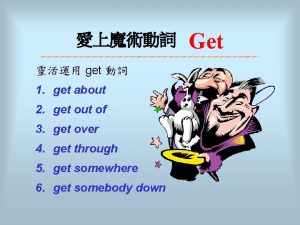Get out Get out your notes for Unit















- Slides: 15

Get out: • Get out your notes for Unit 4 Part 6 and your tree map on James Monroe.

Unit 4 The Early Republic Part 6 • Challenges & Triumphs During the Monroe Administration

• Long-standing tensions between the U. S. & England were eased by two treaties during Monroe’s tenure. • 1817 – The Rush-Bagot Agreement created a demilitarized zone in the Great Lakes Region & ended border tensions between the U. S. & British Canada. • 1818 – The border between the U. S. & Canada was formally set by the Treaty of 1818.

• 1817 – Concern over the effects of slavery within the U. S. led to the formation of the American Colonization Society. The ACS wanted to end slavery in the South but feared doing so would create racial chaos as blacks were integrated into society. To avoid this, they proposed sending freed slaves back to Africa. • Monroe helped the ACS obtain land in Africa, which ultimately became the nation of Liberia.

• White planters in the South opposed the ACS, fearing an end to slavery would mean economic collapse. • Richard Allen, the founder of the African Methodist Episcopal (AME) Church, also opposed the ACS but for a different reason. While he wanted an end to slavery, he believed blacks born in the U. S. should be allowed to remain as free citizens. • The ACS failed to abolish slavery but did establish an independent nation in Africa.

Timed Pair Share • 1 minute discussion with FACE PARTNER – “What do you think about the solution to end slavery by sending former slaves back to Africa? Was this a plausible solution? What flaws were in this plan? ”

• During the early 1800’s, Seminoles used Spanish Florida as a base to raid settlements in Georgia. • 1818 – Andrew Jackson led U. S. troops into Florida, occupied the capital, & forced the Spanish governor to resign. • Spain demanded that the U. S. punish Jackson, but although the invasion was an act of war, Jackson was defended by John Quincy Adams, the Secretary of State. Where have we heard his name before?

• 1819 – The issue of Spanish Florida was settled by the Adams-Onis Treaty. The U. S. gained ownership of Florida from Spain in exchange for $5 million & land along the Gulf Coast of Texas.

• By 1819 the U. S. had 11 free states & 11 slave states. The Senate was therefore equally divided, but the greater population of Northern states gave them a majority in the House of Representatives. • Missouri applied for statehood as a slave state. This caused concern on both sides since the admittance of Missouri would upset the political balance.

Solutions? • Table Discussion –What possible solutions are there to this problem?

• 1820 - The Missouri Compromise was reached, enabling both Missouri & Maine to enter the union. Missouri was entered as a slave state while Maine joined as a free state. • The Missouri Compromise also banned slavery north of Arkansas for any new states created from within the Louisiana Territory.

• By 1820, many Spanish colonies in Latin America had declared independence from Spain, which had been severely weakened by years of mismanagement & the Napoleonic Wars. The nations of continental European formed an alliance against these colonies to prevent the spread of revolutions ^ maintain the Spanish Empire as a European power. However, England & the U. S. sided w/ the new nations of Latin America.

• 1823 – With British support, the U. S. issued the Monroe Doctrine, which stated the American continents were closed to further European colonization. The Monroe Doctrine further stated the U. S. would remain neutral in European affairs but claimed the Americas as within the U. S. sphere of influence, & demanded Europe remain neutral in Latin American affairs in return.

• Realistically, the U. S. could not enforce the Monroe Doctrine w/ either military force or economic coercion; however, England supported the Monroe Doctrine & committed naval power to discourage other European nations from challenging the policy. • The Monroe Doctrine protected newly-formed American nations, established U. S. dominance in the Western Hemisphere, & became the cornerstone of U. S. foreign policy for over a century.

Future impact? 1. How do you think the Monroe Doctrine will affect the future of our foreign policy? 2. Can you see its impacts even today? 3. Was this a success or a failure for Monroe?
 Song with poetic devices
Song with poetic devices Get on get off get in get out
Get on get off get in get out You put your right foot in
You put your right foot in Give us your hungry your tired your poor
Give us your hungry your tired your poor Unit 6 review questions
Unit 6 review questions Facteur g
Facteur g Iso 22301 utbildning
Iso 22301 utbildning Novell typiska drag
Novell typiska drag Tack för att ni lyssnade bild
Tack för att ni lyssnade bild Ekologiskt fotavtryck
Ekologiskt fotavtryck Varför kallas perioden 1918-1939 för mellankrigstiden
Varför kallas perioden 1918-1939 för mellankrigstiden En lathund för arbete med kontinuitetshantering
En lathund för arbete med kontinuitetshantering Adressändring ideell förening
Adressändring ideell förening Personlig tidbok fylla i
Personlig tidbok fylla i A gastrica
A gastrica Förklara densitet för barn
Förklara densitet för barn




























